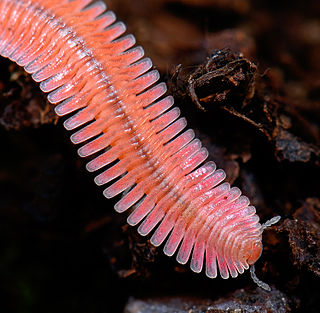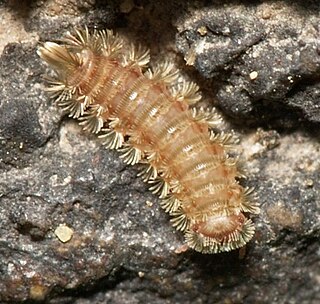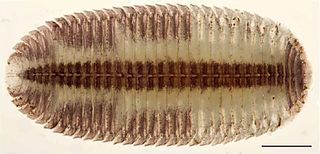 W
WPill millipedes are any members of two living orders of millipedes, often grouped together into a single superorder, Oniscomorpha. The name Oniscomorpha refers to the millipedes' resemblance to certain woodlice (Oniscidea), also called pillbugs or "roly-polies". However, millipedes and woodlice are not closely related ; rather, this is a case of convergent evolution.
 W
WThe Archidesmida is an extinct order of millipedes known from fossils from the Devonian period of Europe and North America. Archidesmidans have broad flat keels (paranota) extending from their body segments, and a modified pair of legs on the 8th segment that may have been involved in mating, similar to the gonopods of living millipedes which insert sperm into females. Alternately, the modified legs may have been used to grasp onto partners during mating.
 W
WArthropleura is a genus of extinct millipede arthropods that lived in what is now northeastern North America, Great Britain and Germany around 345 to 295 million years ago, from the Viséan stage of the lower Carboniferous Period to the Asselian stage of the lower Permian Period. The species of the genus are the largest known land invertebrates of all time, and would have had few, if any, predators.
 W
WCallipodida is an order of millipedes containing around 130 species, many characterized by crests or ridges.
 W
WChordeumatida is a large order of millipedes containing some 1200 species with a nearly worldwide distribution. They possess around 30 body segments and reach about 25 mm (0.98 in) in length.
 W
WEuphoberiidae is an extinct family of archipolypodan millipedes known from the Upper Pennsylvanian of Europe and North America. The family includes relatively large millipedes measuring up to 30 cm (12 in) long bearing distinctive spines and were the dominant millipedes of the Pennsylvanian.
 W
WGlomerida is an order of pill-millipedes found primarily in the Northern Hemisphere. They superficially resemble pill-bugs or woodlice, and can enroll into a protective ball. They have twelve body segments, 17 to 19 pairs of legs, and males have enlarged rear legs involved in mating. The order includes about 30 genera and at least 280 species, including Glomeris marginata, the common European pill-millipede. The order contains members in Europe, South-east Asia and the Americas from California to Guatemala. Although historically considered closely related with the similar sphaerotheriidans that also enroll, some DNA evidence suggest they may be more closely related to glomeridesmidans, a poorly known order that does not enroll.
 W
WGlomeridesmida is an order of millipedes in the infraclass Pentazonia containing 2 families and at least 31 species. Glomeridesmida is the only living order of the superorder Limacomorpha. Glomeridesmidans are small and somewhat flattened, possess 22 body segments, and unlike other orders of Pentazonia, are unable to roll into a ball. Ocelli (eyes) are absent. Glomeridesmidans occur in the New World Tropics, Southeast Asia, India, and Oceania. Two species are known cave-dwellers, and, like other troglomorphic animals are translucent from loss of pigment. The five known species of Termitodesmus have a commensal relationship with termites.
 W
WJulida is an order of millipedes. Members are mostly small and cylindrical, typically ranging from 10–120 millimetres (0.39–4.72 in) in length. Eyes may be present or absent, and in mature males of many species, the first pair of legs is modified into hook-like structures. Additionally, both pairs of legs on the 7th body segment of males are modified into gonopods.
 W
WPalaeosoma is an extinct genus of archipolypodan millipedes from the upper Carboniferous of England and Poland. Individuals grew to nearly 20 cm (7.9 in) long and possessed defensive glands (ozopores) located on small raised nodes on the outer edges of the upper surface of each body segment. Species of Palaeosoma were once considered members of the family Euphoberiidae, which contains species with prominent spines, but are now classified in their own family (Paleosomatidae) and own order (Palaeosomatida), as they lack spines and have a combination of features not seen in other Paleozoic millipedes.
 W
WPlatydesmida is an order of millipedes containing two families and over 60 species. Some species practice paternal care, in which males guard the eggs.
 W
WPolydesmida is the largest order of millipedes, containing approximately 3,500 species, including all the millipedes reported to produce hydrogen cyanide (HCN).
 W
WPolyxenida is an order of millipedes readily distinguished by a unique body plan consisting of a soft, non-calcified body ornamented with tufts of bristles – traits that have inspired the common names "bristly millipedes" or "pincushion millipedes". There are at least 86 species in four families worldwide, and are the only living members of the subclass Penicillata.
 W
WPolyzoniida is an order of millipedes in the subclass Colobognatha containing three families and at least 74 described species.
 W
WSiphoniulus is a poorly known genus of millipede containing only two living species: S. alba from Indonesia, and S. neotropicus from Mexico and Guatemala. An additional two fossil species are known from Cretaceous amber. Siphoniulus species are the only members of the family Siphoniulidae and order Siphoniulida, making Siphoniulida the smallest millipede order. Few specimens are known, and their classification is contentious, although most recent studies place them as basal members of the Helminthomorpha.
 W
WSiphonocryptida is an order of millipedes, comprising the sole family Siphonocryptidae. With only seven described species, the Siphonocryptida is the second smallest millipede order, surpassed only by Siphoniulida, with two species.
 W
WSiphonophorida is an order of millipedes containing two families and over 100 species. This order includes the millipede with the most legs, Illacme plenipes.
 W
WSphaerotheriida is an order of millipedes in the infraclass Pentazonia, sometimes known as giant pill millipedes. They inhabit Southern Africa, Madagascar, South and Southeast Asia, Australia and New Zealand. Like the Northern Hemisphere pill millipedes of the order Glomerida, these millipedes can roll into a ball when disturbed. When they are rolled-up, most sphaerotheriidans reach a maximum size of a cherry or golf ball, but some species from Madagascar can even reach the size of an orange. When rolled-up, predators are unable to unravel giant pill millipedes since the margins of their second and last dorsal plates fit perfectly into one another, creating a sealed ball. A few giant pill millipede species are able to produce sound, the only millipedes known to do this. This order of millipedes is also unique in that some African species are used for medicinal purposes.
 W
WSpirobolida is an order of "round-backed" millipedes containing approximately 500 species in 12 families. Its members are distinguished by the presence of a "pronounced suture that runs "vertically down the front of the head". Most of the species live in the tropics, and many are brightly coloured. Mature males have two pairs of modified legs, the gonopods, consisting of the 8th and 9th leg pair: the posterior gonopods are used in sperm-transfer while the anterior gonopods are fused into a single plate-like structure.
 W
WSpirostreptida is an order of long, cylindrical millipedes. There are approximately 1000 described species, making Spirostreptida the third largest order of millipedes after Polydesmida and Chordeumatida.
 W
WStemmiulida is an order of millipedes consisting of approximately 130 species, reaching up to 50 mm in length. It contains a single family, Stemmiulidae.
 W
WZosterogrammidae is an extinct family of millipedes containing three genera, each with a single species. Fossils are known from the Czech Republic, Scotland, and the USA. Zosterogrammidae constitutes the sole family of the order Zosterogrammida.